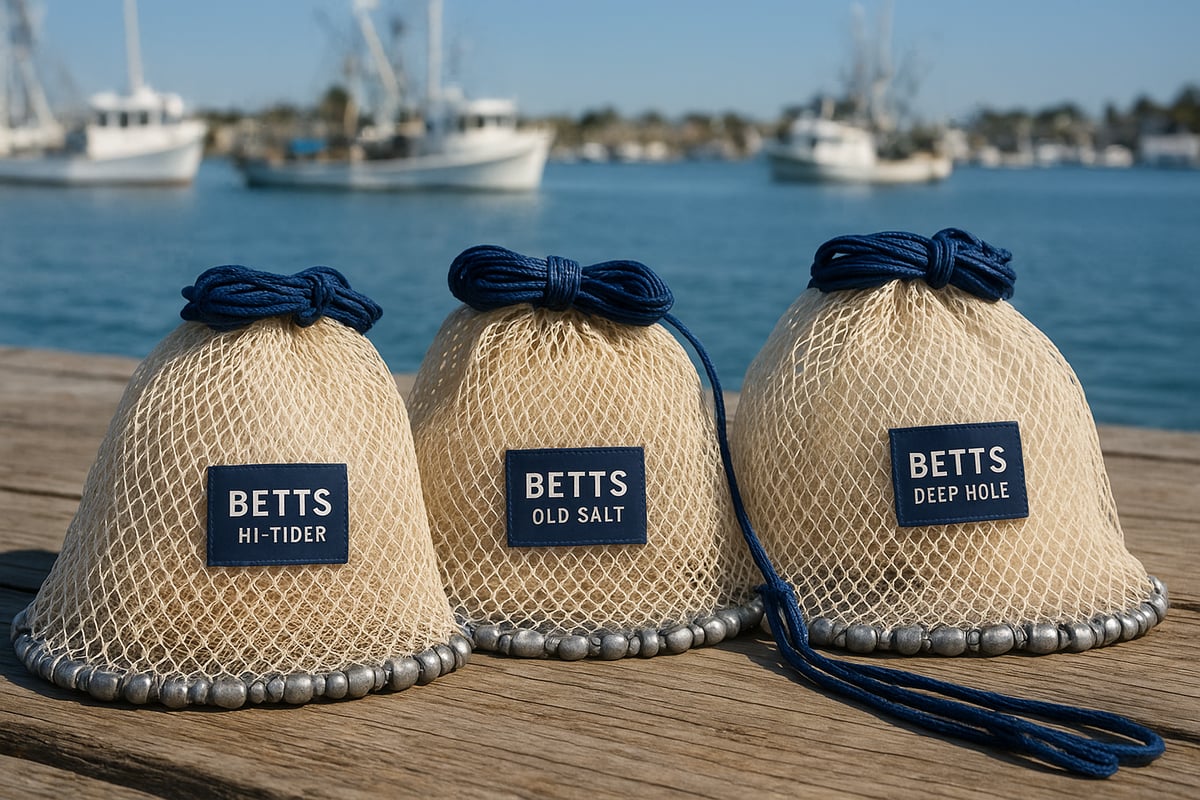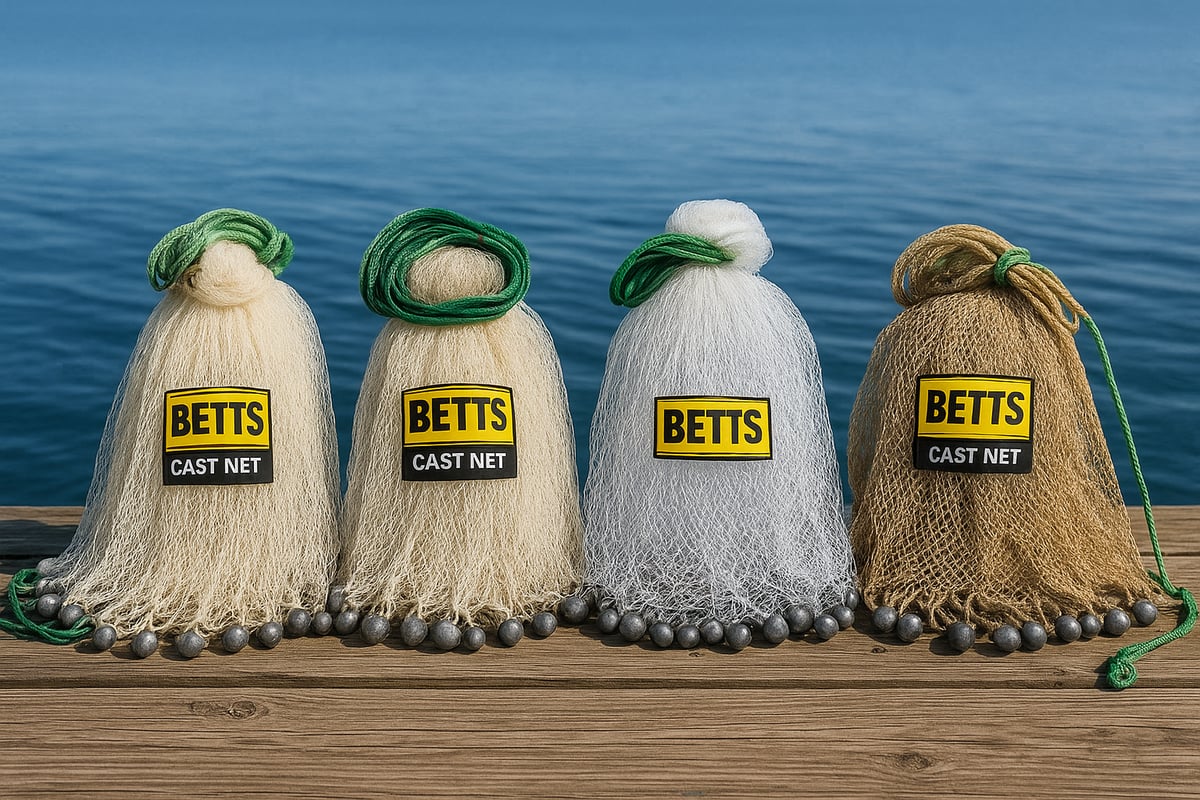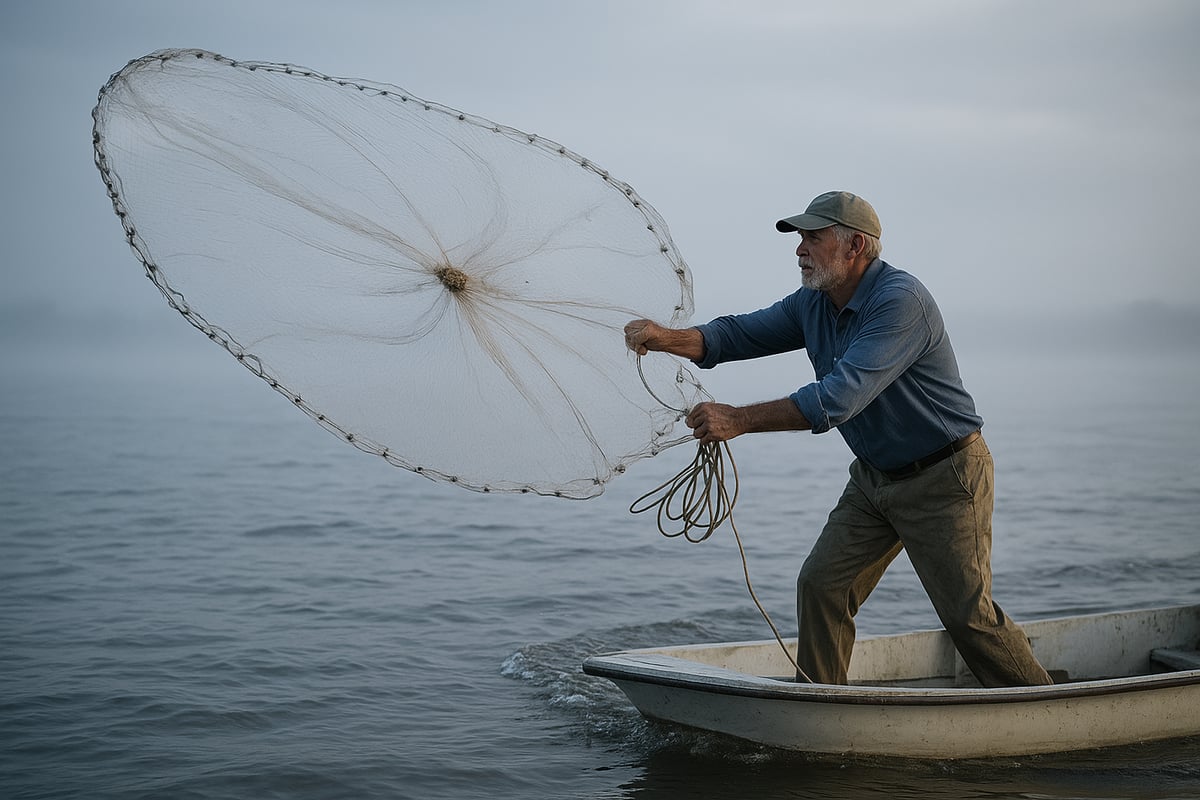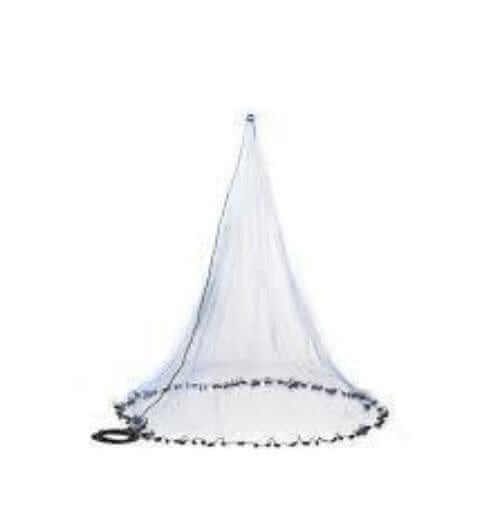Betts cast nets continue to be the top choice for anglers in 2025, trusted for their reliability and proven results on the water. Whether you are a seasoned pro or a first-time user, mastering the betts cast net can dramatically improve your bait-catching success.
This expert guide delivers the latest techniques, tips, and insights needed to get the most out of your gear. You will discover how to select the ideal net, set it up for long-lasting performance, and cast with precision.
From troubleshooting to maximizing your catch rates, every section aims to help you achieve better results. Ready to elevate your skills? Read on for a step-by-step journey to becoming a Betts cast net expert.
Understanding Betts Cast Nets: Features, Types, and Innovations for 2025
Betts cast net holds a reputation as one of the most trusted brands among anglers worldwide. Their consistent innovation and high-quality engineering keep them at the forefront of the market in 2025. From beginners learning the basics to professionals demanding peak performance, Betts cast net remains a top choice for reliability and efficiency.
One hallmark of Betts cast net is their thoughtful design. Nets are crafted from premium nylon or monofilament, offering both durability and smooth casting. Mesh sizes range from ultra-fine (1/4 inch) for small bait to larger 1/2 inch options for targeting bigger species. Radii span from 4 feet for tight spaces up to 12 feet for maximum coverage. Weight systems are meticulously balanced, ensuring the net sinks quickly and opens fully during each throw.
Betts cast net comes in several specialized models. The Hi-Tider is favored for its lightweight feel and ease of use, making it ideal for new users. Old Salt nets are praised for their robust build and versatility, while Deep Hole models feature additional webbing and heavier leads for rapid sinking in deep or fast-moving waters. Specialty versions are available for shrimping or catching delicate baitfish. For a detailed breakdown of specifications and features, anglers can consult the Betts Cast Nets Product Catalog.
In 2025, Betts cast net introduces several innovations. Eco-friendly materials now feature in select models, reducing environmental impact without compromising strength. Enhanced lead distribution systems improve spread and sink rates, and new color-coded handlines help users quickly identify net sizes. These advancements set Betts apart from competitors, who often lag in both sustainability and user-focused design.
Compared to other brands, Betts cast net excels in durability and ease of use. Their nets are known for lasting multiple seasons when maintained properly. User reviews consistently highlight the smooth casting action and reliable pancake spread, which boosts efficiency and catch rates. The Old Salt Deep Hole Cast Net, particularly in the 6 ft radius 3/8 inch mesh with webbing, stands out as a favorite for anglers targeting bait in deeper estuaries.
Selecting the right Betts cast net depends on your target species and fishing environment. Smaller mesh sizes work best for minnows and shrimp, while larger mesh is suited for mullet or menhaden. Deep Hole models are ideal for harbors and tidal rivers, whereas Hi-Tider nets perform well in shallow flats or calm bays.
Recent data shows Betts cast net holds a top market share in North America, with user satisfaction ratings averaging above 4.7 out of 5. Anglers continue to choose Betts for their commitment to quality, innovation, and proven results.

Choosing the Right Betts Cast Net for Your Needs
Selecting the ideal betts cast net is essential for maximizing your catch and ensuring a smooth fishing experience. With a range of environments, species, and legal requirements to consider, making an informed choice will set you up for success.

Assessing Your Fishing Environment
Understanding your fishing environment is the first step in choosing a betts cast net. Start by identifying whether you will fish in freshwater or saltwater, as this affects both net material and maintenance needs. Water depth, current strength, and clarity also play critical roles.
Mesh size should match your target species. For example, a 3/8" mesh is ideal for catching baitfish, while a larger mesh may be needed for mullet or menhaden. The net's radius impacts casting distance and coverage—a 6 ft radius offers a good balance for most situations, but larger nets are better for open water.
Weight is another important factor. Heavier nets sink faster, making them suitable for deep or fast-moving water, while lighter options excel in shallow estuaries. Always match the betts cast net type to your environment. Using the wrong net can reduce catch rates and cause frustration.
Common mistakes include using an oversized net in tight spaces or selecting mesh that is too large for your target species. These errors often lead to poor results and wasted effort.
Comparing Betts Models: Hi-Tider, Old Salt, and More
Betts offers several models, each tailored to specific fishing needs. The Hi-Tider is known for its lightweight construction and easy handling, making it popular among beginners. The Old Salt series, on the other hand, features reinforced webbing and more weight per foot, which allows for faster sinking and greater durability.
The Deep Hole model is engineered for deep water and strong currents, with extra-heavy weights and smaller mesh options. Specialty models are available for shrimp or fine bait, offering unique mesh and size configurations.
Below is a comparison table summarizing key differences:
| Model | Mesh Size Options | Weight per Foot | Best For | Price Range | User Rating |
|---|---|---|---|---|---|
| Hi-Tider | 3/8", 1/2" | Light | Beginners, Shallow | $$ | 4.3/5 |
| Old Salt | 3/8", 1/2", 5/8" | Medium-Heavy | Versatile, All-Around | $$$ | 4.6/5 |
| Deep Hole | 3/8", 1/2" | Heavy | Deep Water, Fast Current | $$$$ | 4.7/5 |
Beginners often prefer the Hi-Tider for its ease of use, while experienced anglers might choose the Old Salt or Deep Hole for challenging conditions. Field-tested performance shows the Old Salt excels in versatility and durability.
For more detailed insights and up-to-date reviews on top models, including user experiences, check out the Best Cast Nets of 2025, Tested and Reviewed.
When deciding between models, consider your target species, environment, and skill level. Choosing the right betts cast net makes every trip more productive.
Sizing and Legal Considerations in 2025
Choosing the correct size for your betts cast net is not only about efficiency but also about following current regulations. Standard net sizes usually range from 4 to 12 feet in radius, but local laws may restrict maximum dimensions or mesh sizes.
In 2025, some regions have updated their rules, limiting certain mesh sizes or requiring nets to be clearly labeled. Always verify the regulations in your area before fishing to avoid fines.
Tips for compliance:
- Measure your net's radius and mesh size accurately.
- Label your net as required by local rules.
- Check for restrictions on specific waterways or species.
Resources such as regional fish and wildlife websites provide up-to-date legal information. Staying informed helps you fish responsibly and ensures your betts cast net remains an asset, not a liability.
Step-by-Step Guide: Preparing, Throwing, and Retrieving a Betts Cast Net
Mastering the use of a betts cast net requires attention to detail at every stage, from setup to retrieval. This section delivers a complete walkthrough, ensuring both beginners and seasoned anglers can achieve consistent results. Follow each step to maximize your catch and extend the life of your net.

Preparation: Setup and Maintenance
Proper preparation is the cornerstone of successful betts cast net fishing. Start by unpacking your net and laying it out flat. Inspect the mesh for any factory defects, paying close attention to knots and the lead line. Attach the handline securely, using strong knots such as the bowline to prevent slippage.
Before your first use, soak the betts cast net in fresh water for several hours to soften the mesh. This step ensures optimal spread on your initial casts. Always rinse the net thoroughly after saltwater outings to prevent salt buildup and corrosion. Dry your net completely before storage to avoid mold and premature wear.
A simple maintenance checklist includes:
- Inspect mesh and lines before each trip.
- Rinse in fresh water after use.
- Dry flat and store away from direct sunlight.
- Check knots and handline for fraying.
Routine care can extend the lifespan of your betts cast net significantly. For more detailed guidance, visit these fishing net setup and care tips to ensure your investment lasts season after season.
Common mistakes include neglecting to inspect for tangles, storing the net wet, or using improper knots. These oversights can reduce performance and shorten net life. Establish a maintenance schedule, such as a weekly deep clean for frequent anglers, to keep your net in peak condition.
Mastering the Throw: Techniques for Every Skill Level
The art of throwing a betts cast net centers on achieving a full, even spread. Begin by coiling the handline neatly in your non-dominant hand. Gather the net’s lead line, allowing the mesh to hang freely.
Follow these steps for a basic shoulder throw:
- Hold the horn of the net in your left hand and the lead line in your right.
- Drape a portion of the net over your throwing shoulder.
- With knees slightly bent, rotate your torso and swing the net outward in a smooth, circular motion.
- Release the net as your body unwinds, aiming for a pancake spread.
Hand positioning and body mechanics are crucial. Keep your grip relaxed but firm. For smaller radius nets, a one-handed toss may suffice, while larger nets require a more coordinated motion for full extension.
Adapt your technique for conditions such as wind or current. When casting from a boat, ensure stable footing and avoid obstacles. Troubleshooting poor throws often involves correcting net loading or adjusting your release angle.
Use this table for common throwing issues:
| Issue | Cause | Solution |
|---|---|---|
| Net does not open | Improper loading | Reload net, check tangles |
| Poor distance | Weak swing, heavy net | Stronger rotation, adjust weight |
| Tangled mesh | Twisted lines, wet storage | Detangle, dry net fully |
With practice, even a 6 ft betts cast net like the Old Salt model can achieve a perfect pancake spread, maximizing your coverage and efficiency.
Efficient Retrieval and Bait Handling
Efficient retrieval is key to protecting your betts cast net and maximizing your catch. After your cast, allow the net to sink fully. Begin pulling the handline steadily, keeping tension constant to minimize snags and tangles.
Once the net is at the surface, use a gentle shaking motion to release bait into your container. For delicate species, handle with care to prevent injury. If the mesh becomes tangled with debris or bait, untangle it immediately to avoid damage during subsequent casts.
Quick recasting during active bait runs is possible if you keep your net organized and ready. Follow a workflow:
- Retrieve and shake out catch promptly.
- Inspect the net for tangles or debris.
- Reload and reposition for the next throw.
Safety is also paramount. Wear gloves to protect your hands from sharp scales or shells. Avoid standing near obstacles that could snag the net or trip you during retrieval.
After fishing, rinse the net thoroughly, allow it to dry, and store it in a cool, dry place. This final step preserves the quality of your betts cast net for future outings.
Advanced Betts Cast Net Techniques and Pro Tips for 2025
Mastering the betts cast net in 2025 means going beyond the basics. Whether you are facing strong currents, chasing elusive baitfish, or troubleshooting on the fly, advanced techniques can elevate your results. This section delivers expert strategies and actionable pro tips to help you maximize every cast and ensure your betts cast net works at peak performance.

Deep Water and Heavy Current Strategies
Deploying a betts cast net in deep water or strong current requires precision and adaptation. Start by selecting a weighted net, such as the Betts Deep Hole model, which sinks quickly and maintains shape in turbulent conditions.
Adjust your throw by:
- Loading more lead into your grip to accelerate sink rate.
- Using a wider stance for stability on boats or piers.
- Casting slightly upcurrent to allow the net to settle naturally over the target spot.
For deeper holes, increase the radius to cover more area, but ensure the mesh size matches your target species. Shrimpers, for example, favor 3/8" mesh in fast-moving tidal rivers.
Positioning is key. Stand where you can cast down-current or across the flow, letting the net open fully before it starts to drift. Many professionals report significant success with the betts cast net Deep Hole model in tidal systems, highlighting its superior performance in challenging environments.
Maximizing Catch Rates: Seasonal and Species-Specific Tactics
To get the most from your betts cast net, align your approach with seasonal shifts and the habits of local baitfish. Timing is critical. Cast at dawn or dusk when bait schools are most active, and focus on tidal changes that move fish closer to shore.
Targeting specific species requires some adjustments:
- For mullet or menhaden, use a larger radius and slightly heavier net.
- Shrimp and smaller baitfish are best caught with fine mesh and quick, repeated throws.
Enhance your success by deploying chum or using underwater lights to draw bait into range. Many seasoned anglers track their average catch rates by season, noting that the betts cast net consistently outperforms competitors in spring and autumn runs.
For those looking to refine their technique further, fishing net review videos provide visual demonstrations of advanced throws, retrievals, and net handling to maximize every outing with a betts cast net.
Troubleshooting and Common Mistakes
Even experienced users encounter issues with their betts cast net. If you notice poor net spread, check for tangles or uneven loading before each throw. Twisted handlines or improperly folded mesh can cause the net to bunch or land off-target.
For field repairs, keep a small kit with spare twine and a needle. Quickly patch small holes or frayed areas to prevent further damage during active fishing.
Stealth matters. Approach bait schools quietly, minimize unnecessary movement, and avoid casting shadows over the water. If you continue to miss targets, consider switching to a different betts cast net model or moving locations to find better conditions.
Common troubleshooting steps:
- Untangle handline and mesh before each cast.
- Inspect weights and webbing for damage.
- Adjust technique based on wind or current.
Reviewing expert demonstrations and repair tips can help you address recurring challenges and keep your betts cast net in top condition for every trip.
Maintaining and Repairing Your Betts Cast Net for Longevity
Proper maintenance and timely repairs are essential for preserving your betts cast net and ensuring reliable performance on every trip. By following a few routine steps, you can extend the life of your net and enjoy consistent results season after season.
Cleaning and Drying Your Betts Cast Net
After each outing, rinse your betts cast net with fresh water to remove salt, sand, and debris. Lay the net flat or hang it in a shaded, well-ventilated area to dry thoroughly. Avoid direct sunlight during drying, as UV exposure can weaken the net material over time.
Regular cleaning prevents mold, mildew, and salt buildup, which can cause premature wear. For frequent anglers, a quick rinse and air dry after every use is recommended.
Inspecting for Damage
Before storing your net, inspect it closely for holes, tears, or frayed lines. Pay special attention to the lead line, mesh, and handline attachment points. Minor damage can escalate quickly, so early detection is crucial.
Run your fingers along the mesh and look for signs of abrasion or weak spots. If you notice a snag or small tear, mark the area for repair before your next outing.
DIY Repair: Step-by-Step
Repairing a betts cast net is straightforward with the right approach. For small holes, use a needle and nylon twine to patch the mesh. Start by threading the twine through the existing mesh, tying secure knots at each junction.
For larger tears, overlap the damaged area and weave new mesh into place, reinforcing the section with extra knots. If the lead line becomes detached, rethread it through the mesh and tie it off tightly.
Example: If your net snags on rocks and develops a 2-inch tear, clean the area, align the torn edges, and use nylon twine to stitch the mesh together, securing each knot firmly.
Tools and Materials for Net Repairs
Having the right tools makes repairs efficient and reliable. Common items include:
| Tool/Material | Use |
|---|---|
| Nylon twine | Patching and knotting |
| Netting needle | Weaving repairs |
| Scissors | Cutting twine and mesh |
| Waterproof glue | Sealing minor abrasions |
A simple repair kit can be stored in your tackle box for quick fixes on the water.
Storing for Longevity
Proper storage is vital for extending the lifespan of your betts cast net. Store your net in a dry, cool place, away from sunlight and moisture. Use a breathable storage bag to prevent mold growth and maintain mesh flexibility.
With regular maintenance and careful storage, a betts cast net can last several seasons. According to user reports, many nets remain effective for over three years with diligent care. For comparison and additional tips on prolonging cast net life, see the Best Cast Nets of 2024.
Replace or Repair: Making the Call
Evaluate the extent of damage before deciding to repair or replace your betts cast net. Small holes and loose lines are often easy to fix, while extensive mesh damage or worn lead lines may justify a replacement.
Consider the cost of repairs versus a new net. If repairs exceed half the value of a new net, replacement may be more practical. Regular inspection and timely repairs help maximize your investment and keep your gear in top condition.
Essential Accessories and Upgrades for Betts Cast Nets
The right accessories can transform your betts cast net experience, making every cast more efficient and every trip more productive. Whether you are a novice or a seasoned pro, the right gear ensures your equipment remains in top condition and your catch rates stay high.
Essential Accessories for Every Angler
Some accessories are simply indispensable for anyone using a betts cast net. Sturdy buckets and bait tanks keep your catch lively, while heavy-duty gloves protect your hands from abrasion during repeated throws. Storage bags are crucial for transporting and protecting your net from sun and salt. For a full range of options tailored to betts cast net users, explore the fishing net accessories and upgrades collection, which features products designed to enhance durability and convenience.
Upgrades and Customization Options
Upgrading your betts cast net can significantly boost performance. Swapping out standard handlines for longer or thicker options provides better grip and control, especially in challenging conditions. Adding extra lead weights or floats allows you to tailor the net’s sink rate and buoyancy for specific environments. Retrieval aids, such as net pullers or clips, make handling larger nets safer and more efficient, reducing fatigue during long sessions.
Accessory Recommendations and Popular Trends
For beginners, starter kits that bundle a betts cast net with a basic set of accessories offer a cost-effective entry point. Professionals often invest in premium handlines, reinforced storage bags, and custom weight systems for maximum efficiency. In 2025, the trend among betts cast net users leans toward eco-friendly materials and ergonomic designs. Accessory kits not only streamline setup and maintenance but also help anglers stay organized and ready for any situation.
Frequently Asked Questions About Betts Cast Net Techniques
Choosing and using a betts cast net raises many questions, especially for those new to the sport. Below, you will find answers to the most frequently asked questions, practical troubleshooting advice, and guidance on legal and support resources. These insights can help you master your technique and avoid common pitfalls.
Common Questions About Betts Cast Net Use
Many anglers wonder, "What mesh size is best for shrimp or baitfish?" For shrimp, a 1/4 inch mesh is ideal, while 3/8 inch mesh works well for most baitfish. Another popular question is how to prevent tangling. Always load the betts cast net carefully, making sure the handline is coiled and the net is not twisted. Beginners often ask if cast nets are hard to throw. With practice and the right technique, even larger nets can be mastered. If you are exploring other options or need a replacement, you can browse American style cast nets for bait for similar models.
Troubleshooting and Pro Tips
Tangled nets, poor spreads, and missed catches are common issues. To avoid tangling, rinse and dry your betts cast net after each use, and store it loosely. If your net fails to open fully, check for knots or debris in the mesh or weights. For persistent problems, try adjusting your grip and practicing the pancake throw. Remember, patience and repetition are key for building muscle memory. If you notice consistent issues, inspect your net for damage or consider a different mesh size for your target species. These tips can significantly improve your results.
Legal Guidelines and Support Resources
Staying compliant with local regulations is essential when using any betts cast net. Net size, mesh, and area restrictions vary by state. For example, Minnesota anglers should review the Minnesota DNR Cast Net Regulations 2025 for up-to-date rules. Always measure your net and label it if required. For replacement parts or product support, contact Betts directly or consult your retailer. Being informed about legal and ethical netting practices helps protect fisheries and ensures a positive experience.
Now that you’ve explored the latest Betts cast net techniques and learned how to choose, care for, and upgrade your gear, you’re ready to put your knowledge into action. Whether you’re just starting out or aiming to perfect your throw for bigger catches in 2025, having the right equipment is key. Action Outdoors Limited offers a trusted range of quality fishing nets and marine supplies, all designed with New Zealand expertise and Pacific anglers in mind. If you’re ready to elevate your fishing game and see real results, take the next step and Buy Now.

